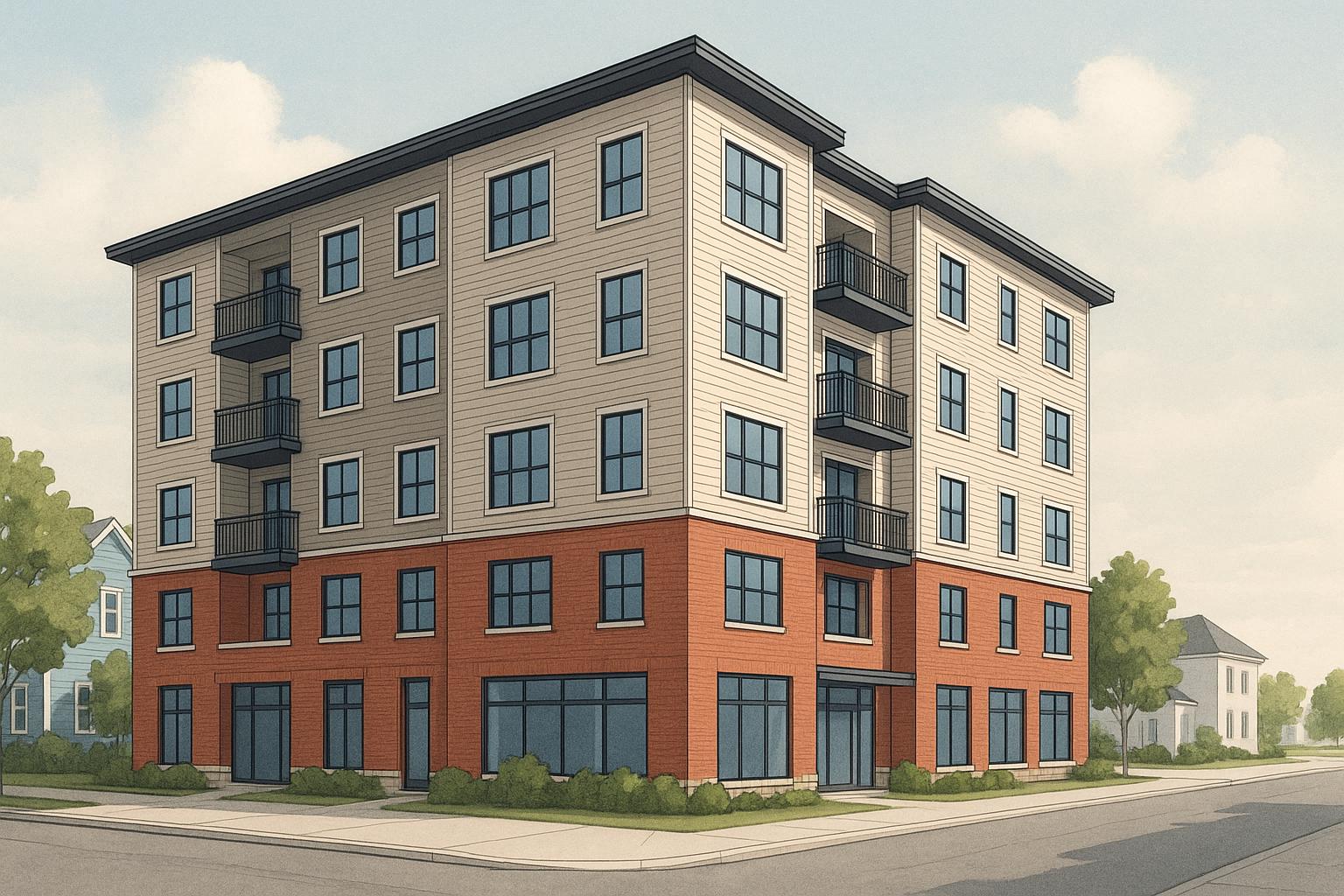Thinking about buying land in Nova Scotia to build your dream home? Here are the five key things you need to check before making the purchase:
- Zoning Rules: Verify local Land Use By-laws to ensure the property allows your planned construction. Use tools like Halifax's Interactive Property Information map to check zoning and special requirements like watercourse buffers or wetland zones.
- Utilities Access: Confirm if the land has municipal water, sewer services, or if private systems (well and septic) are needed. Costs can vary widely, so budget carefully.
- Land Features and Costs: Assess the terrain, soil conditions, and potential risks (e.g., flooding or erosion). Typical site preparation costs range from $1,000 to $5,000+ depending on lot size and location.
- Future Development Plans: Research the area’s growth strategies, like Halifax’s planned residential units, to understand how nearby developments might affect property value and living conditions.
- Property Surveys: Hire a certified surveyor to confirm boundaries, topography, and environmental factors like wetlands or soil stability to avoid costly surprises.
Quick Tip: Assemble a professional team (lawyer, realtor, geotechnical engineer) to guide you through the process and ensure a smooth purchase.
Buying Land in Nova Scotia. What to look for.
1. Check Local Building Rules
Before purchasing land in Nova Scotia, it's important to review the local zoning regulations. Each municipality has its own Land Use By-laws that define what can and cannot be built.
In the Halifax Regional Municipality (HRM), for instance, specific plan areas come with their own unique construction rules.
Here’s how to check local building rules:
- Use Municipal Zoning Maps: Most municipalities provide online zoning tools. For example, HRM offers an Interactive Property Information map, which helps you identify the zoning regulations for any property within its boundaries [1].
-
Consider Special Requirements: Pay attention to these factors:
- Buffers near watercourses
- Restrictions in coastal areas
- Wetland protection zones
- Rules for adding secondary suites
Many municipalities in Nova Scotia provide zoning information online. Here's a quick reference:
| Municipality | Online Resources |
|---|---|
| Halifax (HRM) | 22 land use by-laws; interactive zoning maps |
| Cape Breton Regional | Full zoning map; land use by-law |
| East Hants | Zoning map; detailed by-law |
| Kings County | Land use by-law; comprehensive zoning maps |
If you're considering coastal properties, double-check setback requirements and any environmental protection zones. These rules, such as buffer zones near waterways or wetlands, can limit the area available for building.
Understanding these regulations will help you prepare for the next step - ensuring access to essential utilities.
2. Confirm Water and Power Access
Before moving forward, ensure the land can support the utility systems you need. This step is essential for effective budgeting and planning.
Water and Sewer Options
Take a close look at both municipal and private utility possibilities:
| Service Type | Upfront Costs | Key Considerations |
|---|---|---|
| Municipal Water | $500–$3,000 connection fees | Provides consistent service but involves ongoing bills |
| Private Well | $2,000–$15,000 for drilling | May need a pump and regular water quality testing |
| Municipal Sewer | $500–$3,000 connection fees | Typically available in urban areas |
| Septic System | $3,000–$15,000 installation | Requires soil testing and ongoing maintenance |
Once you’ve reviewed water and sewer options, it’s time to assess your electrical requirements.
Power Connection Process
Get in touch with Nova Scotia Power early in the process. Their Design Review Team can assist you with:
- Outlining electrical needs specific to your project
- Estimating costs for extending power lines if necessary
- Discussing timelines for setting up temporary and permanent power connections
Key Steps to Take Before Buying
- Confirm Municipal Services: Reach out to the local municipality to verify if water and sewer services are available at the property line.
- Perform Soil Testing: For properties requiring a septic system, ensure the land passes percolation tests to confirm it’s suitable.
- Plan for Well Drilling: Notify the Department of Environment at least 24 hours before starting any well drilling. Nova Scotia regulations also require that the driller holds a valid certificate of qualification [3].
If private systems are needed, consult your contractor to determine the scope of work. Costs for well drilling can vary depending on site conditions, while septic system expenses depend on soil type and home requirements [2]. To avoid unnecessary delays or additional expenses, engage Nova Scotia Power’s Design Review Team as early as possible.
3. Review Land Features and Costs
Once utilities are confirmed, the next step is to evaluate your land's terrain and associated site costs. This helps prevent unexpected expenses and keeps your project on track. Take a close look at the land's features and estimate preparation costs, as these can differ significantly depending on the location.
Common Site Development Costs
Here’s a breakdown of typical site preparation costs in Nova Scotia:
| Development Component | Cost Range |
|---|---|
| Initial Land Levelling | $1,000 - $2,500 |
| Municipal Permits | $100 - $600 |
| Site Survey | $300 - $3,000 |
| Basic Grading | $2,500 - $5,000 |
| Site Drainage Systems | $1,000 - $5,000 |
How Lot Size Affects Costs
The size of your property plays a big role in determining site preparation expenses:
- Small lots (under 1 acre): $500 to $2,000
- Medium lots (1–3 acres): $2,000 to $5,000
- Large lots (over 3 acres): $5,000 and up
Key Factors to Consider in Nova Scotia
The province’s geological features call for a detailed evaluation of the following:
- Soil Conditions: Rocky or clay-heavy soils can drive up levelling costs.
- Natural Hazards: Be mindful of risks like flooding, coastal erosion, and landslides.
- Ground Stability: Check for issues like unstable ground, abandoned mines, or sinkholes.
- Water Resources: Assess groundwater availability and quality, which can affect future use.
Steps for a Professional Assessment
To get a clear picture of your site’s requirements, follow these steps:
1. Geological Review
Use resources like the Mineral Resources Branch Land Use Atlas to access geological maps for the area.
2. Site Evaluation
Hire experts to examine:
- Topography and grading needs
- Tree removal requirements
- Drainage and erosion control measures
Ways to Cut Costs
Here are some practical tips to help manage your site preparation budget:
- Schedule work during off-peak times and combine services to save on costs.
- Get at least three quotes for major preparation tasks to compare pricing.
- Use tools like the Coastal Hazard Map to check flood risks before starting.
- Consult the Department of Natural Resources for geological advice and insights.
sbb-itb-16b8a48
4. Study Area Growth Plans
Before purchasing land in Nova Scotia, it's essential to understand future development plans. These strategies can influence property values and the overall living environment.
Current Development Initiatives
The Halifax Regional Municipality (HRM) is actively working to address housing shortages. By March 2022, nine special planning areas were identified, with the potential to add 22,600 new residential units [5]. Here’s a breakdown of the planned developments:
| Location | Planned Units |
|---|---|
| Port Wallace | 4,900 |
| Sandy Lake | 6,000 |
| Dartmouth Crossing | 2,500 |
| Bedford West 1 and 12 | 2,500 |
| Morris Lake | 3,100 |
| Former Penhorn Mall | 950 |
| Southdale/Mount Hope | 1,200 |
| Bedford West 10 | 1,300 |
| Indigo Shores | 150 |
How to Research Area Plans
The Halifax Regional Plan provides a roadmap for growth and development policies through 2031 [4]. To dive deeper, the ExploreHRM tool is a valuable resource. It offers insights into land use zones, upcoming infrastructure projects, future development areas, and other key details. This tool can help you understand the broader planning landscape.
Key Factors to Consider
Halifax is currently dealing with a housing shortage of around 17,000 units [5], which is driving significant development activity. When evaluating a property, make sure to review:
- The community plan designation for the area
- Regional Subdivision By-law requirements
- Updates from the Shape Your City initiative
- Guidance from the Planning & Development Permit Office
5. Get Property Surveys Done
After assessing land features and estimating site costs, it's crucial to confirm all legal and environmental details with a property survey. This step identifies potential issues that could disrupt your plans or increase expenses. A survey works alongside earlier evaluations to provide a complete picture of your site.
Professional Survey Requirements
Hiring a certified Nova Scotia land surveyor ensures you receive detailed documentation, including:
- Precise legal boundary locations and measurements
- Existing structures or encroachments
- Topographical details
- Utility easements and rights-of-way
- Building setback requirements
Environmental Considerations
Nova Scotia is home to 360,462 hectares of freshwater wetlands and 17,060 hectares of salt marsh, which can affect construction plans [6].
"Land commonly referred to as marsh, swamp, fen or bog that either periodically or permanently has a water table at, near or above the land's surface or that is saturated with water, and sustains aquatic processes as indicated by the presence of poorly drained soils, hydrophytic vegetation and biological activities adapted to wet conditions." - Environment Act as amended in 2006 [6]
Key Survey Components
| Survey Element | Purpose | Impact on Building |
|---|---|---|
| Boundary Survey | Confirms property lines | Avoids encroachment issues |
| Topographical Survey | Maps elevation changes | Helps with drainage and foundation |
| Wetland Assessment | Identifies protected areas | Ensures compliance with regulations |
| Soil Testing | Assesses ground conditions | Affects foundation design and costs |
Using Available Resources
Take advantage of tools like NSDNR forest inventory maps and Wet Areas Mapping to gather additional site information.
Common Survey Findings
Property surveys often uncover boundary discrepancies that could lead to legal disputes [7]. Addressing these issues early can save time and ensure your construction project stays on track.
Next Steps
Once you've evaluated your land, it's time to bring in a team of professionals to help you complete the purchase.
Professional Support Team
| Professional | Responsibilities | When to Engage |
|---|---|---|
| Real Estate Lawyer | Handle title searches and legal documents | Before making an offer |
| Geotechnical Engineer | Evaluate soil quality and building suitability | After selecting the land |
| Licensed Realtor | Negotiate terms and manage paperwork | When ready to make an offer |
| Mortgage Broker | Help secure financing for the purchase | Before making an offer |
These professionals will help you pull together the insights from your earlier assessments and guide you through the next steps.
Documentation and Legal Review
Gather the following:
- Municipal zoning confirmation
- Utility setup details
- Geotechnical assessment
- Survey and environmental reports
- Clear title search results
Your real estate lawyer should review all these documents before you sign anything. This ensures the ownership is clear and flags any issues that might affect the purchase.
Final Verifications
Work with local authorities and experts to confirm site-specific requirements. Meet with municipal planners to check setbacks, building heights, drainage, and permit procedures. A geotechnical engineer should also assess:
- Soil composition to determine foundation needs
- Drainage patterns
- Wetland impacts, if any
- Tree removal requirements
- Groundwater conditions
This step ensures everything is in place for a smooth transition to ownership.
FAQs
What zoning restrictions should I consider when buying land for a custom home in Nova Scotia?
When purchasing land in Nova Scotia, it's crucial to understand the zoning and land-use by-laws that apply to the property. Zoning regulations determine what type of buildings or developments are allowed on the lot, including restrictions on the number of units, building height, or specific land uses.
Each municipality has its own zoning rules, so be sure to check the by-laws for your area. For example, Halifax has distinct zoning zones, and tools like property information maps can help you identify which regulations apply to your land. Verifying zoning details early ensures your plans align with local requirements and avoids costly surprises later.
What should I consider when estimating utility and site preparation costs for land in Nova Scotia?
Estimating utility and site preparation costs is a crucial step when purchasing land in Nova Scotia. Start by researching whether the lot has access to municipal water and sewer systems, or if you'll need to install a well and septic system. Costs can vary significantly depending on the location and the type of infrastructure required.
For site preparation, assess the land's condition. Factors like bedrock, steep slopes, or the need for extensive tree clearing can increase expenses. It's a good idea to consult a local contractor or land surveyor for a professional evaluation. Additionally, check local zoning and land-use bylaws to ensure your plans align with the lot’s requirements, avoiding unexpected costs down the road.
By thoroughly investigating these aspects, you can create a more accurate budget and avoid costly surprises later on.
How can future development plans in Nova Scotia affect the value and lifestyle of my property?
Future development plans in Nova Scotia, especially within the Halifax Regional Municipality (HRM), can have a significant impact on your property's value and the quality of life in the area. The HRM Regional Plan sets policies for growth and development, guiding where new infrastructure, housing, and services will be focused through 2031.
Major residential projects are being fast-tracked in designated areas, with plans to add over 22,000 new housing units. These developments can bring benefits like improved amenities and services, but they may also lead to changes in traffic patterns, community dynamics, and local infrastructure demands. Researching these plans before purchasing land can help you make an informed decision and avoid surprises down the road.



